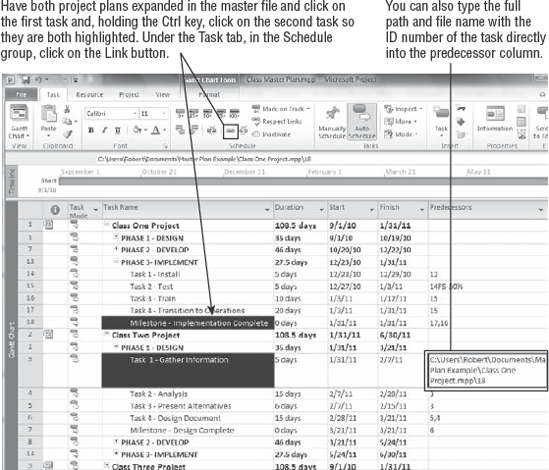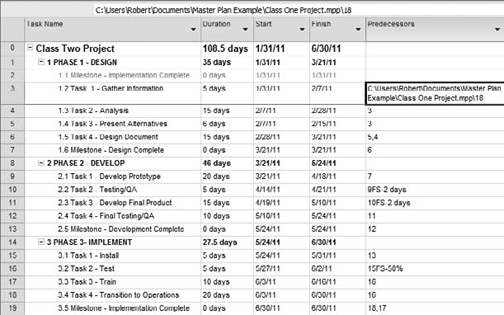2. Setting Up Cross-Project Links
After you've set up a master file with inserted
subprojects, you can create links from one project to another.
Cross-project linking enables project managers to link tasks in one
project to tasks in another project. For example, you may have a task or
milestone in one project that drives a line item, task, or milestone in
another project. When you create a dependency between tasks in
different projects this way, any changes to the start or finish date of
the external task are automatically reflected in the successor task of
the other project.
There are two basic ways to set up
links between projects: You can manually type the path and filename in
the Predecessors column, or you can use the Link tool, as shown in Figure 4.

I've found that it's much easier to create a link
using the Link button in the Schedule group rather than trying to
remember the full path name and correct syntax to type into the
Predecessors column. You also have the option to type directly into the
Successor column if it's displayed in the table.
After cross-project links are established, you can view them in the source files as external links. External relates to those tasks outside of a project. These external tasks are sometimes called ghost tasks, a name that refers to an external (replicated) task, as shown in Figure 5.
External tasks aren't displayed in the master file if
both tasks are expanded and displayed, because they're both in view.
When either project is displayed alone (for example, doesn't contain the
other as an inserted project), the external task is displayed with
special light-gray ghost formatting so you can easily distinguish it
from other tasks. If you're working in the source files, one project
gets an external successor task and the other gets an external
predecessor task.
If an external task is displayed as a ghost task in
the active project, it gets its own ID in the active project (not
necessarily the same ID it has in its parent project). A predecessor
ghost task is inserted just before the corresponding internal successor
task, and a successor ghost task is inserted just after the
corresponding internal predecessor task. However, if a ghost task
representing the external task already exists, then that ghost task is
used to represent the external task in all the relationships it may have
with tasks in the active project. In other words, if two tasks in the
active project both have the same external predecessor, only one ghost
task represents that external task in the active project.

While you're in the source file viewing the external
link, you can also edit it. If you double-click a cell in a ghost task,
Project opens the external project and places the cursor at the proper
task. The cross-project link can be edited in either project.
You can delete the ghost task
from the internal task's project. Doing so removes the link and removes
the ghost task from the internal project. This action has no effect on
the external task in the external project except to remove the
cross-project link (and the appropriate ghost task) when that project is
updated.